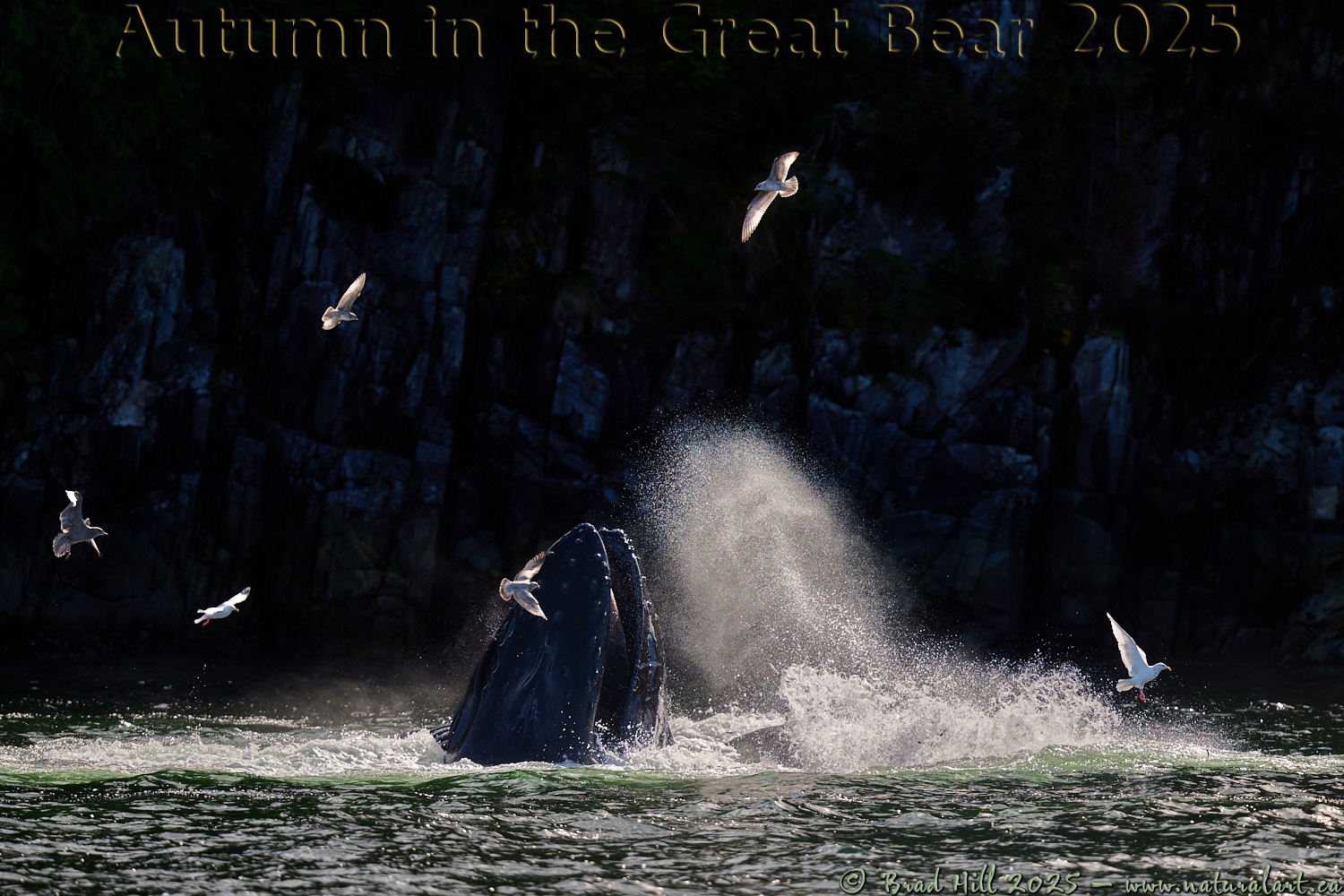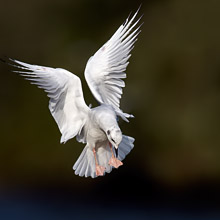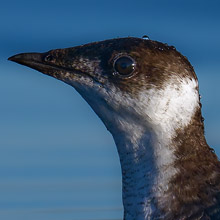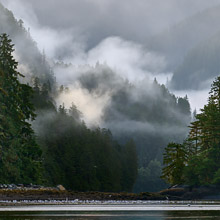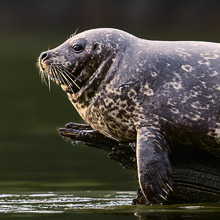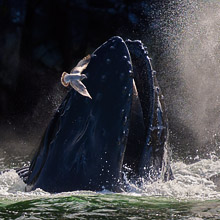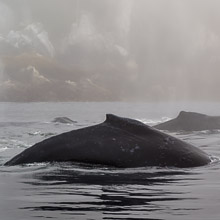Availability: Undetermined - Enquiries?
In the Field
Raw West Coast Energy. Great Bear Rainforest, British Columbia, Canada. September 27, 2025.
There are few wildlife "scenes" more dramatic than that of Humpback Whales bubble netting. Add in strong backlighting, the usual assemblage of gulls that are drawn in to feast on the "collateral damage", and a steep, shaded cliff face in the background, and you have just an amazing spectacle to watch (and to photograph)! 😉
Some might suggest that the gulls in this photo (which are a mix of Short-billed Gulls and Glaucous-winged Gulls) are a bit of a distraction to the main subject (the whale!). I disagree. Not only are gulls almost always found with bubble-netting humpbacks (and are thus an integral part of the total bubble-netting spectacle), but to me they add a very nice touch of contrast and visual interest to the shot. Of course, both they and the bright frothing water added a big challenge to capturing the shot...both from a exposure compensation perspective and a dynamic range perspective.
I captured this image using a Nikon Z 9 body with a Sigma Sports 200mm f2 lens attached. Nikon-shooting technophiles might be scratching their head right now thinking "Hmmm...that lens isn't available in the Nikon Z-mount." And, they'd be right - it's available only in the Sony E-mount and the Panasonic L-mount. However...Nikon's large-diameter Z-mount allows the development of adapters that permit lenses from other makers (with smaller diameter mounts) to be used on Nikon's Z bodies. Which, when you think of it, is kinda cool.
I mounted this very fast (and optically amazing!) Sigma 200mm f2 (Sony mount) to my Z 9 using a Megadap ETZ21 Pro+ mount adapter. This adapter is weather-sealed (which, as someone who shoots a lot in very wet conditions, is critical for me) and the adapter supports the AF of the Nikon body and, much to my surprise, even allows you to use lens function buttons on the Sigma lens (and they work as they would on a Nikon lens).
I am a lover of fast (wide-aperture) lenses - and years back I owned a copy of Nikon's 200mm f2 VR II lens (and just loved it). Between the compression effect you get with the 200mm focal length and the very thin DoF provided by the f2 aperture a 200mm f2 lens produces a very unique look to an image (and its a look I just love). While it's possible Nikon is going to produce their own Z 200mm f2 lens in the future, my best guess is that they won't. Fortunately, lens mount adapters like the Megadap ETZ21 Pro+ allow Nikon Z body owners to use lenses that Nikon or 3rd party lens makers (like the Sigma Sports 200mm f2) that simply aren't available in the Z-mount. Very cool.
On a final note...I felt I took a bit of gamble in buying (without any form of pre-purchase testing) the Sigma Sports 200mm f2 lens and the Megadap lens adapter. Fortunately, the gamble paid off! On the first photo tour I took the Sigma 200mm f2 on in the autumn of 2025 the majority of my favourite images from the photo tour were captured with the 200mm f2. Phew! 😉
Here's a larger version (4800 pixel) of this high energy scene:
• Raw West Coast Energy: Download 4800 pixel image (JPEG: 4.7 MB)
ADDITIONAL NOTES:
1. These images - in all resolutions - are protected by copyright. I'm fine with personal uses of them (including use as desktop backgrounds or screensavers on your own computer), but unauthorized commercial use of the image is prohibited by law. Thanks in advance for respecting my copyright!
2. Like all photographs on this website, these images were captured following the strict ethical guidelines described in The Wildlife FIRST! Principles of Photographer Conduct. As such, no baiting or any form of attractant was used and, as always, we attempted to minimize our impact on the ongoing behaviour of the subjects. I strongly encourage all wildlife photographers to always put the welfare of their subjects above the value of their photographs.
3. This image was captured during my Autumn in the Great Bear Exploratory Photo Adventure in early Autumn of 2025. Each year I offer photo tours into various locations on the amazing BC coast, including the Great Bear Rainforest and, every other year, into the Khutzeymateen Grizzly Sanctuary (to photograph grizzlies, of course!). Details about these trips can be found on the Photo Tours page of this website.
Behind the Camera
Raw West Coast Energy. Great Bear Rainforest, British Columbia, Canada. September 27, 2025.
High Efficiency* Compressed RAW (NEF) format; ISO 250.
Nikon Z 9 paired with Sigma 200mm f2.0 DG OS Sports adapted to the Z-mount using a Megadap ETZ21 Pro+ mount adapter. Hand-held from sailboat. VR off. Wide AF custom (13x3) area mode with subject detection on "Birds" mode.
1/6400s @ f2; -1.3 stop compensation from matrix-metered exposure setting.
At the Computer
Raw West Coast Energy. Great Bear Rainforest, British Columbia, Canada. September 27, 2025.
Initial noise reduction and capture sharpening on the .nef (raw) file using the DeepPRIME XD2S algorithm of DXO PhotoLab 9.1 Elite (using the lens/camera optical module of the Nikon Z9 + Nikkor 200mm f2 VR II).
Subsequent adjustments to the adjusted linear DNG file (exported from PhotoLab) and conversion to 16-bit TIFF file (and JPEG files for web use) - including all global and selective adjustments - made using Capture One Pro (build 16.6.3). In the case of this image the only global adjustment made was to overall contrast (using a Levels adjustment). Selective local adjustments performed using Capture One Pro's layers and masking tools. In this case numerous small adjustments and minor tweaks were made on 3 separate layers, with the tweaks being associated with "exposure balancing" and contrast adjustments (such as adjustments to brightness, clarity, highlights, shadows, blacks, etc.).
Photoshop modifications included insertion of the watermark and/or text.
Conservation
Raw West Coast Energy. Great Bear Rainforest, British Columbia, Canada. September 27, 2025.
Species Status in Canada**: Threatened - North Pacific population (May 2003).
Humpback Whales (Megaptera novaeagnliae) are active, acrobatic whales that can throw themselves completely clear of the water (a behaviour known as breaching) and will swim on their backs with both flippers in the air. Humpbacks are large (up to 14m - or 46 feet - in length and 40 tonnes in weight) and with huge flippers.
Humpbacks are found in tropical, temperate, and sub-polar waters around the world. They are found on both the east and west coasts of North America. The North Pacific population has been estimated at between 6,000 and 8,000 individuals, but only a few hundred of these are found in the waters off the coast of British Columbia.
While Humpbacks are recovering from the damage done to their populations by commercial fishing, the are still subject to a variety of threats from human activities, including becoming entangled in fishing nets, noise and chemical pollution and habitat destruction.
**as determined by COSEWIC: The Committee on the Status of Endangered Wildlife in Canada













